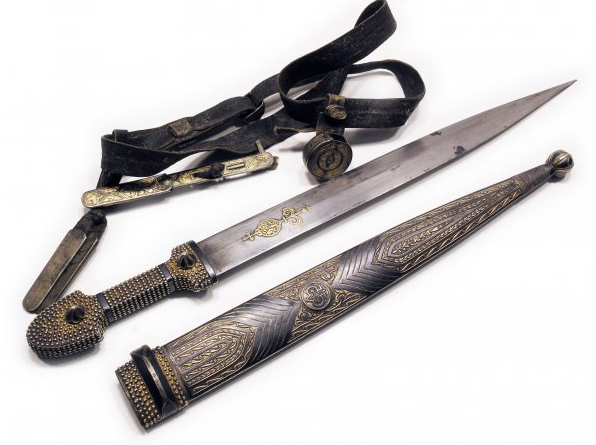qama on:
[Wikipedia]
[Google]
[Amazon]
 The qama ( fa, قمه, ady, къамэ , ce, шаьлта, ka, ხანჯალი ) is a short
The qama ( fa, قمه, ady, къамэ , ce, шаьлта, ka, ხანჯალი ) is a short
 The qama ( fa, قمه, ady, къамэ , ce, шаьлта, ka, ხანჯალი ) is a short
The qama ( fa, قمه, ady, къамэ , ce, шаьлта, ka, ხანჯალი ) is a short Caucasian
Caucasian may refer to:
Anthropology
*Anything from the Caucasus region
**
**
** ''Caucasian Exarchate'' (1917–1920), an ecclesiastical exarchate of the Russian Orthodox Church in the Caucasus region
*
*
*
Languages
* Northwest Caucasian l ...
dagger. It has a long, wide double-edged blade and is native to the North Caucasus
The North Caucasus, ( ady, Темыр Къафкъас, Temır Qafqas; kbd, Ишхъэрэ Къаукъаз, İṩxhərə Qauqaz; ce, Къилбаседа Кавказ, Q̇ilbaseda Kavkaz; , os, Цӕгат Кавказ, Cægat Kavkaz, inh, ...
. The qama was also traditionally carried by the Cossacks
The Cossacks , es, cosaco , et, Kasakad, cazacii , fi, Kasakat, cazacii , french: cosaques , hu, kozákok, cazacii , it, cosacchi , orv, коза́ки, pl, Kozacy , pt, cossacos , ro, cazaci , russian: казаки́ or ...
who adopted it from the peoples of the Caucasus
The peoples of the Caucasus, or Caucasians, are a diverse group comprising more than 50 ethnic groups throughout the Caucasus.
By language group
Language families indigenous to the Caucasus
Caucasians who speak languages which have lo ...
, and is commonly referred to as the "Cossack dagger
A dagger is a fighting knife with a very sharp point and usually two sharp edges, typically designed or capable of being used as a thrusting or stabbing weapon.State v. Martin, 633 S.W.2d 80 (Mo. 1982): This is the dictionary or popular-use de ...
". It resembles the Roman gladius
''Gladius'' () is a Latin word meaning "sword" (of any type), but in its narrow sense it refers to the sword of ancient Roman foot soldiers. Early ancient Roman swords were similar to those of the Greeks, called '' xiphe'' (plural; singular ''xi ...
and Scottish dirk
A dirk is a long bladed thrusting dagger.Chisholm, Hugh (ed.), ''Dagger'', The Encyclopædia Britannica, 11th ed., Vol. VII, New York, NY: Cambridge University Press (1910), p. 729 Historically, it gained its name from the Highland Dirk (Scot ...
.
As the Kabardian linguist Shagirov writes, the name of the dagger came from the Turkic languages
The Turkic languages are a language family of over 35 documented languages, spoken by the Turkic peoples of Eurasia from Eastern Europe and Southern Europe to Central Asia, East Asia, North Asia (Siberia), and Western Asia. The Turkic languag ...
(see, for example, Turkish ''kama'' "dagger", Karachay-Balkar
Karachay-Balkar (, ), or Mountain Turkic (, ), is a Turkic language spoken by the Karachays and Balkars in Kabardino-Balkaria and Karachay–Cherkessia, European Russia, as well as by an immigrant population in Afyonkarahisar Province, Turkey. I ...
''qama'' "dagger").Шагиров А. К. Этимологический словарь адыгских (черкесских) языков. А-Н. - М.: Наука, 1977
"''къIамэ/къамэ 'кинжал'.''
''~ Ср. абх.-абаз. а-къIама/къама. убых. къхамэ то же. Из других иберийско-кавказских языков слово представлено в картвельских и нахских (чеченский). Оно имеет распространение также в тюркских (турецком, крымско-татарском. ногайском, карачаево-балкарском, таранчинском говоре уйгурского языка, туркменском), иранских (осетинском. персидском. курдском) и балканских языках (см. TMEN III 406-407. ИЭС II 261). Согласно Дёрферу, в иранских языках лексема заимствована из тюркских или кавказских, в балканских языках - из турецкого. Первоисточник, по его мнению, может быть кавказским (иберийско-кавказским). Автор отмечает, что среди тюркских слово встречается особенно в тех языках, которые соседят с кавказскими. Дальнейшее распространение оно могло получить, считает Дёрфер, через эти (соседние) тюркские языки (TMEN III, там же). Абдоков пытается разъяснить лексему на абхазо-адыгской почве, привлекая Iэ (< *къIэ) в адыгском ŷ́ыIэн (< *ŷыкъIэн) 'ранить' и абхазо-абазинское -къI-, ср. а-п-къI-ра/п-къI-ра 'резать'. Высказывается предположение, что къIамэ/къамэ образовано по типу ŷымэ (см.) от глагольной основы с помощью инструментального аффикса -мэ (см. Фонет. и лекс. параллели 13,35). Неубедительно. Правильнее ориентироваться все же на тюркский материал, ср. тур. kama, ног. кама. карач.-балк. къама 'кинжал’. Тюркское слово может содержать суффикс -ма, образующий от глагольных основ различные имена, в том числе существительные со значением орудия действия (см. Аффиксы словообразования 132, 133)''".
References
European swords Knives Blade weapons {{Knife-stub